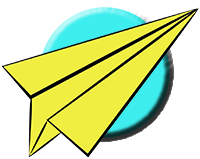Venus Paper Airplane Folding Instructions
Venus Paper Airplane Folding Instructions
Instructions
1. Fold the paper exactly in half along its long edge. Unfold after the crease has been made.
2. Fold the upper left corner down so the upper left point hits the right edge of the paper. When folded correctly, the top edge should line up with the right edge of the paper.
3. Unfold after the crease has been made. Fold the upper right corner down so the upper right point hits the left edge of the paper. When folded correctly, the top edge should line up with the left edge of the paper.
4. Unfold after the crease has been made and lay the paper flat on the work surface
5. Flip the paper over keeping the existing creases towards the top.
6. Fold the upper left and right points down so they hit the points formed by the existing diagonal creases. When folded correctly, a new horizontal crease is created which goes through the center point. Unfold after the crease has been made.
7. Flip the paper over, keeping the existing creases towards the top.
8. Fold the upper left corner down so the upper left point hits the center line crease. When folded correctly, the left half of the top edge should line up with the center line crease.
9. Fold the upper right corner down so the upper right point hits the center line crease. When folded correctly, the right half of the top edge should line up with the center line crease.
10. Pop the left and right horizontal creases up, bringing the points at the ends of the crease in and down towards the center of the paper. When folded correctly, a new flap is formed sticking straight up from the paper's base.
11. Split the layers of the flaps apart bringing the point at the top down towards the center line crease. Two new creases are created as the fold is pressed flat.
12. Rotate the paper around so the nose is pointing to the right.
13. Fold the paper exactly in half along the existing center line crease. Be sure to line up the wing flaps for good balance.
14. Make a crease for the first wing flap. The right point of the fold should be at the tip of the nose and the left point should be about two finger widths down from the center fold.
15. Flip the plane over so the first wing flap is underneath and the nose points to the right.
16. Make a crease for the second wing flap. Be sure to line up the wing flaps for good balance.
17. Flip the plane over, keeping the nose to the right.
18. Fold the upper nose flap down so the top edge of the flap lines up with the bottom of the fuselage.
19. Unfold the flap just created.
20. Rotate the plane around so the nose is up and pointing away from you.
21. Pop the two layers of the nose flap open and bring the flaps over and down about the existing creases. Press the fold and flat against the working surface
22. Fold the outer part of the nose flap up over the inner part rotating about the existing crease at the base of the fuselage.
23. Flip the plane over, keeping the nose to the right and the wing flaps down.
24. Fold the top-most nose flap in half so the top edge of the flap lines up with the main center line crease. Unfold after the crease has been made.
25. Rotate the plane around so the nose is pointing up and away.
26. Pop the two layers of the nose flap open and bring the flaps over and down about the existing creases. Press the fold down and flat against the working surface.
27. Fold the bottom part of the nose flap up and over the upper part rotating about the existing crease at the base of the fuselage.
28. Fold the top part of the wing flap down. The crease should be parallel with the main center line crease about three finger widths up from the bottom edge of the fuselage.
29. Flip the plane over, keeping the nose to the left.
30. Fold the other wing flap up. Make sure the folds are even for good balance.
31. Open up the wing flaps and the nose flaps and adjust all of the angles so they are even. The main wings should have a definite down dihedral angle. All the angles between the nose flaps should be about equal.
THE THROW Launch gently at a slight up angle. If the plane spirals or flutters to the ground, adjust the dihedral angle slightly up so the wings are flatter. This craft is capable of long straight flights as long as it is launched gently.
